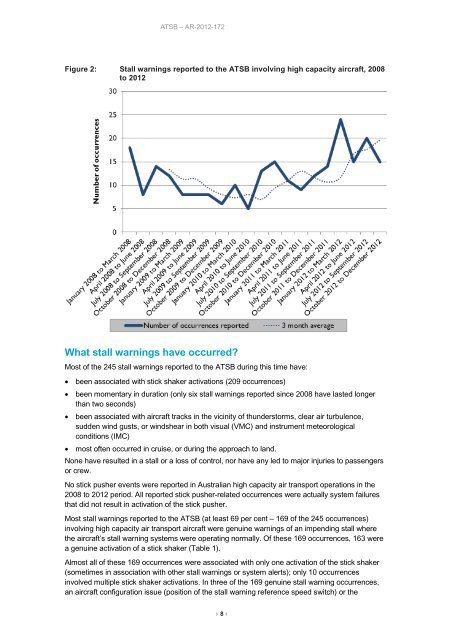Stall warnings in high capacity aircraft: The Australian context 2008 ...
Stall warnings in high capacity aircraft: The Australian context 2008 ...
Stall warnings in high capacity aircraft: The Australian context 2008 ...
You also want an ePaper? Increase the reach of your titles
YUMPU automatically turns print PDFs into web optimized ePapers that Google loves.
ATSB – AR-2012-172<br />
Figure 2: <strong>Stall</strong> <strong>warn<strong>in</strong>gs</strong> reported to the ATSB <strong>in</strong>volv<strong>in</strong>g <strong>high</strong> <strong>capacity</strong> <strong>aircraft</strong>, <strong>2008</strong><br />
to 2012<br />
What stall <strong>warn<strong>in</strong>gs</strong> have occurred?<br />
Most of the 245 stall <strong>warn<strong>in</strong>gs</strong> reported to the ATSB dur<strong>in</strong>g this time have:<br />
• been associated with stick shaker activations (209 occurrences)<br />
• been momentary <strong>in</strong> duration (only six stall <strong>warn<strong>in</strong>gs</strong> reported s<strong>in</strong>ce <strong>2008</strong> have lasted longer<br />
than two seconds)<br />
• been associated with <strong>aircraft</strong> tracks <strong>in</strong> the vic<strong>in</strong>ity of thunderstorms, clear air turbulence,<br />
sudden w<strong>in</strong>d gusts, or w<strong>in</strong>dshear <strong>in</strong> both visual (VMC) and <strong>in</strong>strument meteorological<br />
conditions (IMC)<br />
• most often occurred <strong>in</strong> cruise, or dur<strong>in</strong>g the approach to land.<br />
None have resulted <strong>in</strong> a stall or a loss of control, nor have any led to major <strong>in</strong>juries to passengers<br />
or crew.<br />
No stick pusher events were reported <strong>in</strong> <strong>Australian</strong> <strong>high</strong> <strong>capacity</strong> air transport operations <strong>in</strong> the<br />
<strong>2008</strong> to 2012 period. All reported stick pusher-related occurrences were actually system failures<br />
that did not result <strong>in</strong> activation of the stick pusher.<br />
Most stall <strong>warn<strong>in</strong>gs</strong> reported to the ATSB (at least 69 per cent – 169 of the 245 occurrences)<br />
<strong>in</strong>volv<strong>in</strong>g <strong>high</strong> <strong>capacity</strong> air transport <strong>aircraft</strong> were genu<strong>in</strong>e <strong>warn<strong>in</strong>gs</strong> of an impend<strong>in</strong>g stall where<br />
the <strong>aircraft</strong>’s stall warn<strong>in</strong>g systems were operat<strong>in</strong>g normally. Of these 169 occurrences, 163 were<br />
a genu<strong>in</strong>e activation of a stick shaker (Table 1).<br />
Almost all of these 169 occurrences were associated with only one activation of the stick shaker<br />
(sometimes <strong>in</strong> association with other stall <strong>warn<strong>in</strong>gs</strong> or system alerts); only 10 occurrences<br />
<strong>in</strong>volved multiple stick shaker activations. In three of the 169 genu<strong>in</strong>e stall warn<strong>in</strong>g occurrences,<br />
an <strong>aircraft</strong> configuration issue (position of the stall warn<strong>in</strong>g reference speed switch) or the<br />
› 8 ‹
















